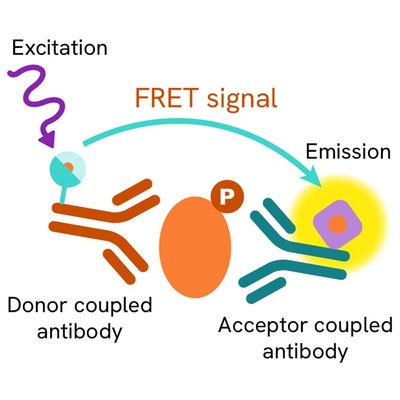

HTRF Mouse Phospho-SLP76 (Ser376) Detection Kit, 500 Assay Points








| Feature | Specification |
|---|---|
| Application | Cell Signaling |
| Sample Volume | 16 µL |









Product information
Overview
This HTRF cell-based assay enables rapid, quantitative detection of mouse SLP-76 phosphorylated on Serine 376. Phospho-SLP-76 creates a scaffold on which key signaling complexes are built, and is a marker of T-lymphocyte activation.
How it works
Mouse phospho-SLP-76 (Ser376) assay principle
The Mouse phospho-SLP-76 (Ser376) assay measures mouse SLP-76 when phosphorylated at Ser376. Unlike Western Blot, the assay is entirely plate-based and does not require gels, electrophoresis, or transfer. The Mouse phospho-SLP-76 (Ser376) assay uses 2 labeled antibodies: one with a donor fluorophore, the other one with an acceptor. The first antibody was selected for its specific binding to the phosphorylated motif on the protein, and the second for its ability to recognize the protein independent of its phosphorylation state. Protein phosphorylation enables an immune-complex formation involving both labeled antibodies and which brings the donor fluorophore into close proximity to the acceptor, thereby generating a FRET signal. Its intensity is directly proportional to the concentration of phosphorylated protein present in the sample, and provides a means of assessing the protein’s phosphorylation state under a no-wash assay format.

Mouse phospho-SLP-76 (Ser376) 2-plate assay protocol
The 2 plate protocol involves culturing cells in a 96-well plate before lysis, then transferring lysates to a 384-well low volume detection plate before the addition of mouse phospho-SLP-76 (Ser376) HTRF detection reagents. This protocol enables the cells' viability and confluence to be monitored.

Mouse phospho-SLP-76 (Ser376) 1-plate assay protocol
Detection of mouse phosphorylated SLP-76 (Ser376) with HTRF reagents can be performed in a single plate used for culturing, stimulation, and lysis. No washing steps are required. This HTS designed protocol enables miniaturization while maintaining robust HTRF quality.

Simplified pathway
Function and regulation of SLP-76
TCR engagement promotes the phosphorylation of immunoreceptor tyrosine-based activation motifs (ITAMs) on the cytosolic side of the TCR/CD3 complex by lymphocyte protein tyrosine kinase (Lck). Zap-70 is recruited to the TCR/CD3 complex, where it becomes phosphorylated and activated. ZAP-70 phosphorylates SLP-76. Activated SLP-76 translocates to the plasma membrane and promotes a multi-protein complex, which participates in the activation, survival, and proliferation of T-Lymphocytes.

Specifications
| Application |
Cell Signaling
|
|---|---|
| Brand |
HTRF
|
| Detection Modality |
HTRF
|
| Lysis Buffer Compatibility |
Lysis Buffer 1
Lysis Buffer 2
Lysis Buffer 4
|
| Molecular Modification |
Phosphorylation
|
| Product Group |
Kit
|
| Sample Volume |
16 µL
|
| Shipping Conditions |
Shipped in Dry Ice
|
| Target Class |
Phosphoproteins
|
| Target Species |
Mouse
|
| Technology |
TR-FRET
|
| Therapeutic Area |
Oncology & Inflammation
|
| Unit Size |
500 assay points
|
Video gallery
Resources
Are you looking for resources, click on the resource type to explore further.
Emerging pathways to neuroinflammation and neurodegeneration
Neurodegenerative diseases, such as amyotrophic lateral sclerosis...
This guide provides you an overview of HTRF applications in several therapeutic areas.
Advance your autoimmune disease research and benefit from Revvity broad offering of reagent technologies


Loading...
How can we help you?
We are here to answer your questions.






























